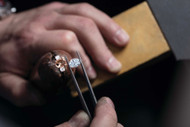Sep 1st 2023
Learn the History of Lab Grown Diamonds
You’re in a state of shock. You started shopping for an engagement ring and just found out that lab grown diamonds exist! What are these beauties and how are they made? How long have they been available for purchase? We’re here to break it all down for you.
What are Lab Grown Diamonds?
Before we go any further, what exactly are lab grown diamonds? As the name suggests, they’re real diamonds that are created in laboratories! They’re made of carbon and possess the same qualities as natural diamonds, including look, durability and sparkle. So, we don’t expect you to tell them apart. Only trained gemologists can do that with special equipment.
Since lab grown diamonds have the same composition as natural diamonds, they’re equally durable. Both score a perfect 10 on the Mohs Hardness Scale, a scale that ranks the scratch-resistance of diamonds, gemstones and other minerals.
Lab grown stones also go through the same intense grading process as natural diamonds. Each diamond is evaluated on the 4 C’s: color, clarity, cut and carat weight.
Popularity of Diamonds
So, why create a lab grown diamond? Over time, shoppers have shown a growing interest in diamonds. According to the International Gem Society, scientists first realized in the late 1700s that natural diamonds were made from pure carbon. And as a result, they became determined to produce a human-made diamond.
But when it comes to engagement rings, diamonds weren’t always the standard stone. Prior to the 1930s, only 10% of rings featured diamonds! That changed after diamond retail and manufacturing corporation DeBeers took a hit during the Great Depression. To generate more excitement around diamonds, DeBeers developed an advertising campaign that connected diamonds with engagement rings.
The tactic worked. By the end of the 20th century, diamonds sparkled in roughly 80% of engagement rings, creating even greater demand for the glistening gems.
History of Lab Grown Diamonds
Despite the early discovery of carbon as diamonds’ chemical makeup, it wasn’t easy to replicate diamonds in a laboratory. Plenty of scientists claimed to have succeeded, but the attempts weren’t confirmed.
H. Tracy Hall and a group of fellow scientists at General Electric (GE) are credited with producing the first reported lab grown diamonds in 1954. They essentially placed a graphite seed, another mineral featuring carbon, into a tube and applied heat and pressure until it transformed into a diamond.
However, these early lab grown diamonds were ultimately too small to be used in jewelry. So, they were reserved for industrial use instead. Commercially available lab grown diamonds didn’t hit the market until the 1970s, making them a relatively new phenomenon in the jewelry industry.
But they’re becoming popular among younger shoppers today due to their affordability. Lab grown stones are known to cost 30-40% less than their natural counterparts. Some say they’re also more environmentally friendly to produce than natural diamonds.
How are Lab Grown Diamonds Made Today?
Laboratories use two procedures: HPHT, which stands for “high pressure, high temperature,” and Chemical Vapor Deposition (CVD). HPHT is the primary process, and conditions that formed natural diamonds beneath the Earth’s surface are recreated with high pressure and high temperatures. As a result, lab grown diamond crystals develop. GE used a form of this method to create the first lab grown versions.
Under CVD, molecules of a carbon-rich gas, like methane, are broken down into carbon and hydrogen atoms. These carbon atoms are left to settle like snow onto a flat surface until a square-shaped diamond crystal forms.
Both procedures allow diamonds to be created in a matter of weeks. So, they’re more widely available and therefore cost-effective.
Have a question? We can help!
Gage Diamonds is Chicago's premier jewelry showroom and online retailer of engagement rings, wedding bands, and fine jewelry. We offer a selection of dazzling handpicked diamonds, including certified natural and lab grown diamonds.
We’re committed to helping you find the ring of your dreams. For inspiration, browse our selection of natural and lab grown diamonds, or set up an appointment with a member of our trusted staff at our in-person showroom.
We offer no-credit-needed financing – feel free to apply and get your approval within 24 hours!
Pay over time, because love shouldn’t wait.
 VISIT OUR SHOWROOM
VISIT OUR SHOWROOM Reviews on Google!
Reviews on Google!




